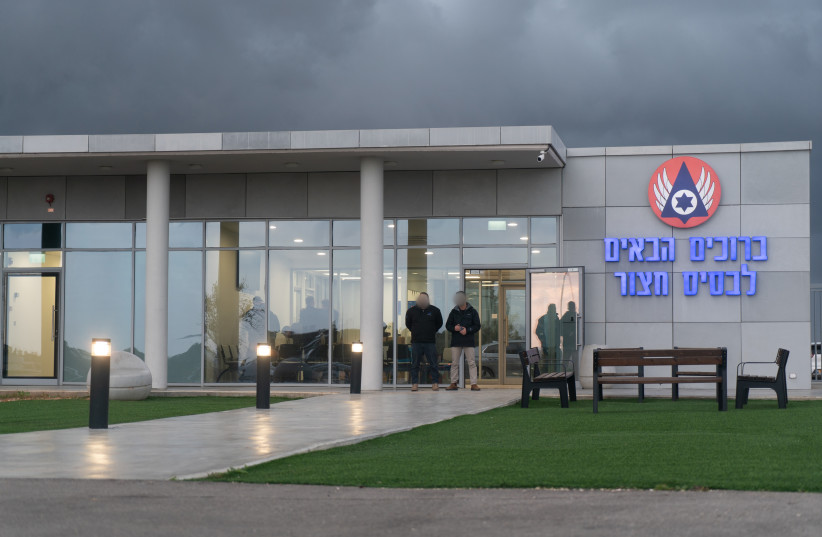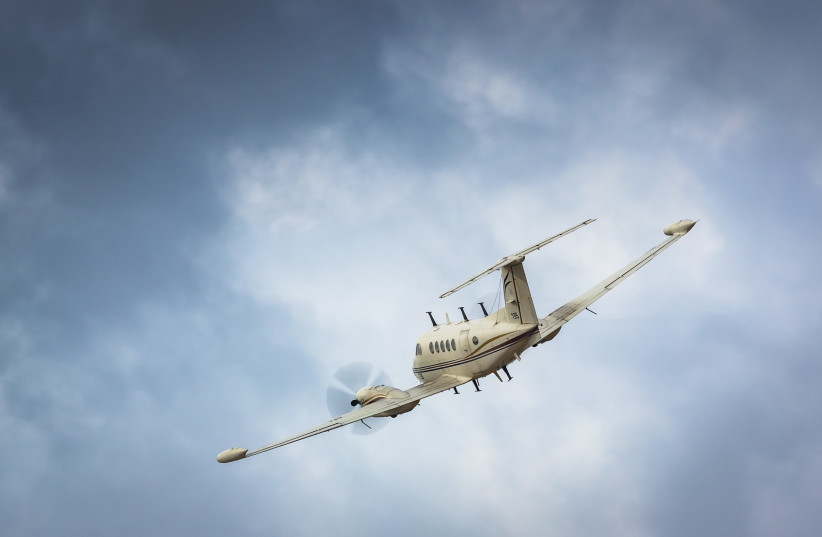“I am the grandson of Holocaust survivors,” IAF Lt.-Col. “S” told The Jerusalem Post in his opening statement, to make it clear how seriously he views his responsibility as commander of Squadron 100 – whose task is to act as Israel’s spy in the sky.
He said his grandmother, who survived the Holocaust and who died two months ago, was very emotional when she heard that he had taken command of the squadron in September.
S told the Post, during a visit to Hatzor air base, that he joined the air force in 2005, graduating as a pilot in 2008 and then serving in a range of roles in the air force spy unit before becoming its commander.
Squadron 100 is the oldest air force unit in the IAF and the only unit that has operated continuously since the founding of the state in all its conflicts. It is currently celebrating its 75th anniversary, along with the State of Israel.
Unit 100: The flying camel
Ironically, Squadron 100’s history and its myths are symbolized by its insignia, a flying camel.
Legend has it that during the British Mandate and the transition to statehood, word was that the fledgling Israeli state would never succeed in establishing an air force. In fact, the doubters said camels would fly before Israel establishes one.
Set up in November 1947, Squadron 100 has been involved in every significant conflict since then – and even now, it is involved daily in operations on every front.

The IDF only announces a fraction of its operations against Iranian proxies in Syria and has not formally confirmed several attacks in the last two weeks, but it has admitted to many other attacks in Syria in recent years.
Incidentally, since the spy aircraft can observe terrain up to 100 kilometers away, they can see all the way up to Damascus from the Israeli side of the Golan Heights without having to cross into Syrian airspace.
S told the Post that his unit’s aircraft have “enhanced monitors which collect intelligence for the IDF’s target bank, for intelligence surveillance in general, and for a variety of special operations.”
The commander said that Squadron 100 has also had “excellent cooperation with IDF land forces in the West Bank,” this past year as Israel has faced terror attacks from there.
“We guard and warn our forces on the ground, who are in danger zones with the enemy, to help them avoid danger,” he said.
A novel aspect of Squadron 100 is that “sometimes a ground forces representative sits in the aircraft with us. Earlier, the representative would have presented a briefing about their mission, what they fear might go wrong and what intelligence they want the aircraft to gather,” S explained.
“Combining meeting on the ground earlier with flying together in the air creates deep synergy. This works for the Paratroopers, Golani forces and even a variety of non-IDF security agencies,” he said.
Close working relations on the ground and in the air means that when sudden stressful and unexpected changes come up in the field, such as civilians jumping into the picture, the air force and intelligence groups are able to stay on the same page, S said.
The level of trust, common language and understanding of each other’s concerns is much deeper, so that sometimes an attack can be postponed, circling back to carry out the attack at a slightly different time without losing focus.
Unit 100 helps avoid civilian casualties
Another critical aspect of S’s work is that his unit helps avoid civilian casualties.
“If there is any doubt, we are the gatekeepers and we often delay an attack. And if we hit someone whom we are not supposed to hit, we are responsible,” he said sternly.
S said he and his charges speak clearly to the forces who are pulling the trigger “when there is any dilemma” – and that there have been plenty of times that the IDF took casualties by having to send in ground forces because his team called off using air power to avoid harming Palestinian civilians.
A unique challenge that Squadron 100 faces could be, for example, when the mission is to collect intelligence about a house which is surrounded by various buildings.
“Sometimes, we cannot see everything in a first fly-by. Then I have to report to base that I don’t have the ability to see enough and that they shouldn’t attack now. Or wait until we can do another fly by from a different angle that will be less obscured by the building,” he stated.
The Squadron 100 commander also explained that four spy cameras at the bottom of the aircraft send their pictures to two different computer monitors inside. Two members of the crew can each look at two of the camera’s footage items simultaneously on their respective screens.
The two footage items appearing show a zoom in for detail and a zoom out, to be able to see if any innocent civilians in the close surrounding areas are moving from a safe distance to being closer to the danger zone.
The “Tzofit” – the IAF’s Hebrew designation for its US-made twin-turboprop Beechcraft King Air B200 – is Squadron 100’s main aircraft, but it also operates the “Hofit,” the single-engine Beechcraft Bonanza 36.
Whereas the Tzofit normally fits between five and seven personnel per flight, the Bonanza accommodates a maximum crew of four.
One of the most interesting things about the King Air is that when it jumps from five crew members to seven, it is usually because there are one or more persons joining as “clients” – other security forces. S said that he and his team work regularly enough with these other security forces to develop strong personal relations. This is another advantage they provide which drones cannot.

Another advantage is speed.
Squadron 100’s aircraft fly at a speed of up to 500 kph, much faster than drones, and they can be in situ within about 30 minutes after receiving the order to scramble, a flight time of no more than about 15 minutes. They can be essentially anywhere in the country in 30-40 minutes of flight time, depending on which aircraft type is deployed.
These aircraft can get to the West Bank in a mere 10 minutes, where they have had to provide extra coverage this past year.
Curiously enough, they can start scanning distant areas sometimes only a few minutes after takeoff if the areas are open and the long-range cameras and sensors can already be used en route to the destination.
Some of the systems can also take thermal readings for forces on the ground to be able to know exactly where enemy forces are situated or hiding, as well as directing units toward areas with less light, to avoid detection.
Unlike many other complex Israeli aircraft and drones, Squadron 100’s aircraft are built to fly in inclement weather conditions and their surveillance instruments work even with very poor visibility.
There are currently three female pilots and around 20 female personnel operating and deciphering the video footage instruments. Regarding the technical and logistics teams, which keep the aircraft flight-ready, S estimated that the percentages might be as high as 30% women.
